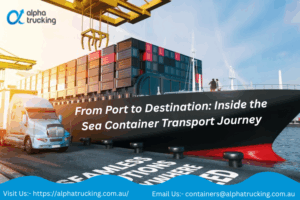
Sea container transport is the lifeblood of global trade—and Australia is no exception. Whether it’s electronics arriving from Asia, wine heading to Europe, or fresh produce moving between ports, the journey of a sea container is far more complex (and fascinating) than most people realise.
from its arrival at the port to its final destination—highlighting the logistics, challenges, and technologies that power this essential supply chain service in Australia.
What Is Sea Container Transport?
At its core, sea container transport involves moving standardized containers via cargo ships across oceans. Once these containers reach a port, they are unloaded and transported to their final inland destination using rail, trucks, or a combination of both.
This system offers an efficient, secure, and scalable solution for moving large quantities of goods both domestically and internationally.
Why It Matters in Australia
Australia’s island geography makes maritime transport essential. Over 98% of Australia’s international trade by volume is carried by sea. Ports like Sydney, Melbourne, Brisbane, and Fremantle serve as critical gateways, connecting Australian businesses to global markets.
Given the vast distances between major cities and ports, intermodal transport—a mix of sea, rail, and road—is key to ensuring timely deliveries across the country.
Step 1: Container Loading at Origin Port
The journey begins at the point of export. Goods are packed into containers at the supplier’s warehouse or a container freight station. Containers are then sealed, documented, and moved to the origin port using trucks or rail, depending on distance and availability.
At the port, containers are queued, checked, and loaded onto large container ships using specialized cranes.
Step 2: Ocean Voyage
Once loaded, the vessel departs and begins its journey to the destination port—often travelling thousands of kilometres over several weeks.
Depending on trade routes, ships may pass through international ports for refuelling, customs clearance, or cargo consolidation.
Challenges at Sea:
- Weather delays (storms, cyclones)
- Port congestion at intermediate stops
- Schedule changes due to global supply chain issues
Step 3: Arrival at Australian Port
Upon arrival at an Australian port, containers go through:
- Quarantine inspection (especially important for biosecurity)
- Customs clearance
- Weighing and scanning for compliance and safety
Once cleared, the containers are unloaded using giant ship-to-shore cranes and placed in the port’s container yard for temporary storage.
Step 4: Inland Transport – Rail or Road?
Once out of the port, the container must reach its final inland destination—this could be a distribution centre, warehouse, or even a retail store.
There are typically two options:
Option 1: Rail Transport
Ideal for long-haul freight (e.g., Sydney to Perth or Melbourne to Brisbane), rail container transport is efficient and eco-friendly. Containers are loaded onto flatbed rail wagons and moved to inland terminals or logistics hubs.
Advantages:
- Cost-effective for bulk freight
- Lower emissions
- Less affected by traffic congestion
Option 2: Road Freight
Best suited for shorter distances or urgent deliveries, trucks offer door-to-door flexibility and speed.
Advantages:
- Direct delivery
- Greater scheduling flexibility
- Suitable for last-mile logistics
Often, businesses use a combination of both rail and road container transport, depending on location and urgency.
Step 5: Final Delivery and Unloading
The final leg of the sea container transport journey ends with the container arriving at the consignee’s location. It is unloaded, contents are inspected, and the container is either:
- Returned to the shipping company
- Stored for reuse
- Repositioned for another shipment
Some containers are repurposed for storage or even modified for other uses (e.g., pop-up cafes or portable offices!).
Key Challenges in the Australian Context
Despite its efficiency, sea container transport in Australia isn’t without challenges:
- Port congestion in major cities
- High domestic transport costs due to long inland distances
- Limited rail infrastructure in some regions
- Weather disruptions, especially during cyclone season in the north
Government and private sector investments are ongoing to modernise port infrastructure and expand intermodal transport networks.
Conclusion
Understanding the journey of sea container transport helps businesses plan better, optimise inventory, and avoid costly delays. Whether you’re an importer, exporter, or third-party logistics provider, knowing what happens from port to destination is critical.
Australia’s reliance on maritime trade, combined with vast inland distances, makes efficient container logistics a cornerstone of economic growth.





